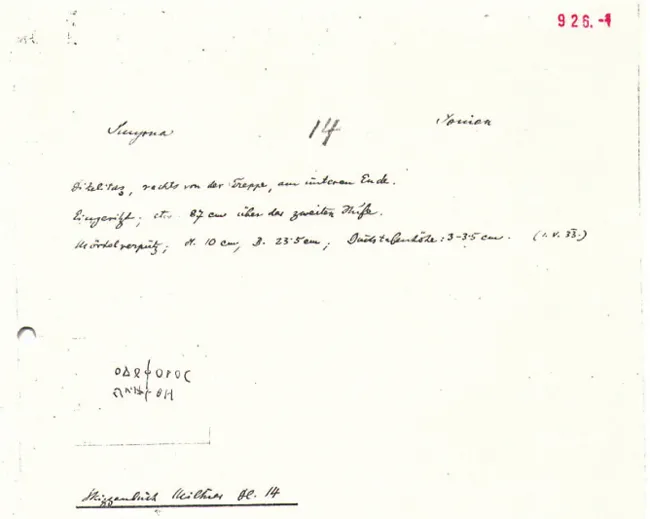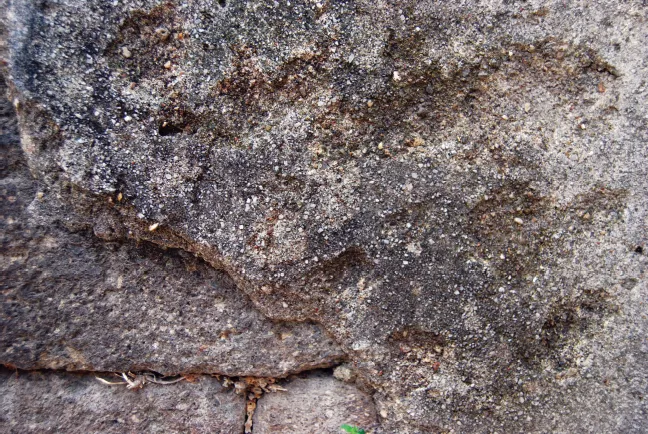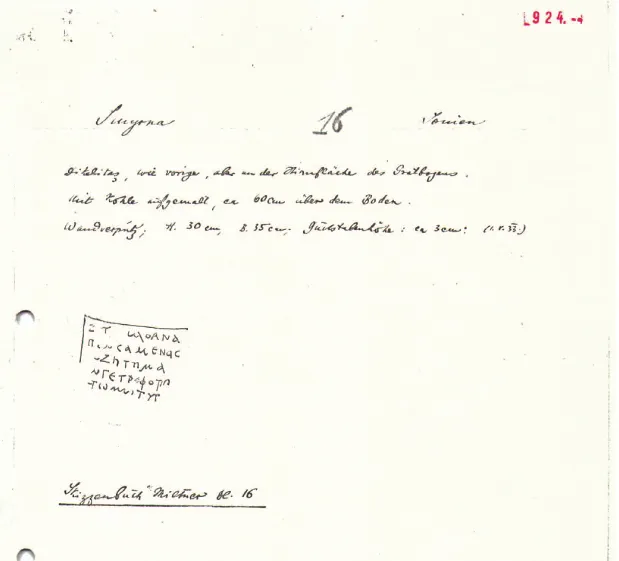![]()
THE GRAFFITI
The texts and descriptions below reflect in first instance the state of the plaster in the Basilica as of July, 2003, when the texts were copied by Bagnall. Thomas Drew-Bear was able to check some of these copies at that time. Photographs taken both in 2003 and 2004 and subsequently have also been used in preparation of the descriptions and texts. A complete revision against the originals was undertaken by Bagnall and Tanrıver in October, 2012, and the photographic documentation completed at that time. Subsequently, conservation by the Smyrna Agora excavations has allowed new photography of graffiti previously covered by bandages or obscured by dirt. Newly-discovered graffiti have been copied by Tanrıver. In addition, photography by an infrared digital camera has provided new images of many of the graffiti. A revision of the recently discovered texts by Bagnall and Tanrıver in September, 2014 completed the documentation of the texts, and at the same time Casagrande-Kim was able to check all of the drawings against the originals.
The graffiti discovered in 2003 and subsequently are preceded here by three copied by Franz Miltner and preserved in the archives of the Kleinasiastische Kommission in Vienna. Only the first of these graffiti still partly survives, and we give texts based on the copy kindly supplied by G. Petzl from the archives.
The graffiti were originally assigned numbers based on the numbering of the bays at the time of excavation. These are the numbers used in Bagnall 2011, and wherever possible these are retained here to avoid the confusion that would result from simply replacing them. “Tn.x” thus means “T(ext) x in Bay n.” “D” refers to “Drawing” in analogous manner. Those bay numbers on the north side run from 0 to 46. A second numbering of bays, prefixed with G, was later introduced. These numbers run from G1 to G50. They are used here for reference to graffiti only where there is not an “original” bay number, but their numbers are provided side-by-side with the original ones. “TPn.x” or “DPn.x” indicates that the text is written or drawn on a pier in the row to the south of the bays where most of the graffiti are located, in the middle of the basement. Piers have been numbered with A numbers (for “ayak” in Turkish) from 1 to 59 on the north side, 60 to 116 in the middle, and 117 to 175 on the south side. The bays in the south gallery have been renumbered with a separate series of P1 to P54; only two of these have any graffiti, however, and these are given both the older numbers and the P numbers. The reader will find a concordance to the systems at the end of the book (p. 479); they are also shown on the plan provided here (Fig. 4).
A 121 (STAIRS)
To the right of the staircase, at the lower end, 87 cm above the second step. Incised in plaster. The underlined letters were still visible in 2014; the plaster of line 2 has been lost. Dimensions 23.5 cm wide × 10 cm high; letters 3–3.5 cm high. Facsimile: Miltner.
1. If this is not broken at left, one would naturally read *ὁδοφόρος, “road-bearing” or “road-bearer.” As this word is not otherwise attested to our knowledge, more promising would be the assumption of a lost letter and a reading ῥοδοφόρος.
2. See the drawing. The initial letter(s) could be omicron, epsilon, epsilon iota, or perhaps sigma upsilon. The first eta is also indistinct in Miltner’s copy and could represent something else. The only suggestion for an intepretation that has occurred to us is συνήρθη, aorist passive of συναίρω. We cannot propose a suitable meaning with either the putative *ὁδοφόρος or ῥοδοφόρος with any confidence.
The third vault from the west, ca. 1 m above the floor. Dimensions 20 cm wide × 30 cm high. Charcoal letters 3 cm high. Traces of at least four lines were seen above the recorded text. Facsimile: Miltner.
. Ω . .
ΜΟΥΣ
ΑΔΕΛΦ
ΤΗΣΜ
ΤΡΟΣ ̣
̣ ΟΝΑ
ΑΡΑ ̣
3–5 Presumably a form of ἀδελφός or ἀδελφή, perhaps followed by τη̑ς μητρός and perhaps a name.
The third vault from the west, front [= south?] side of the vault, ca. 6 cm above floor level. Dimensions 30 cm wide × 35 cm high. Letters ca. 3 cm high. To judge from the drawing, apparently in a tabula. Facsimile: Miltner.
Ζ[ . ]Τ[ . . ] . ΟΑΝΑ
Π . . ΣΑΜΕΝΟΣ
[ . ] . ζήτημα
[ . ] . ΓΕΤΡ ̣ ΦΟΡ ̣
[ . ] . Ω . . . Τ . .
1. It is hard not to suppose that originally the line began with ζήτημα, as in line 3 and in T0.4, T8.2, and T28.1. Following that, one might think of ἀναγινώσκων, but that would require more loss at right than the drawi...





